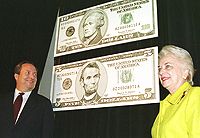Fed Tasks: The Government's Bank
The Fed maintains the checking account of the U.S. Treasury. As the largest bank customer in the country, the U.S. government does quite a bit of business and performs a lot of financial transactions, all of which are handled by the Fed. These transactions amount to trillions of dollars and include all of the tax deposits and withdrawals for U.S. citizens. It also includes securities such as savings bonds, Treasury bills, notes, and bonds that are bought by and for the U.S. government.
Coin and paper currency produced by the U.S. Treasury's Bureau of the Mint and Bureau of Engraving and Printing is distributed to financial institutions by the Fed as part of its role as the government's bank.
Advertisement
The Fed also monitors the condition of currency and either sends it back into circulation or has it destroyed. Because there are times during the year when people need more cash, currency is stored at Reserve Banks so that banks can order more paper money as they need it. These "orders" are paid for with funds from the bank's reserve account balance held with the Fed.
